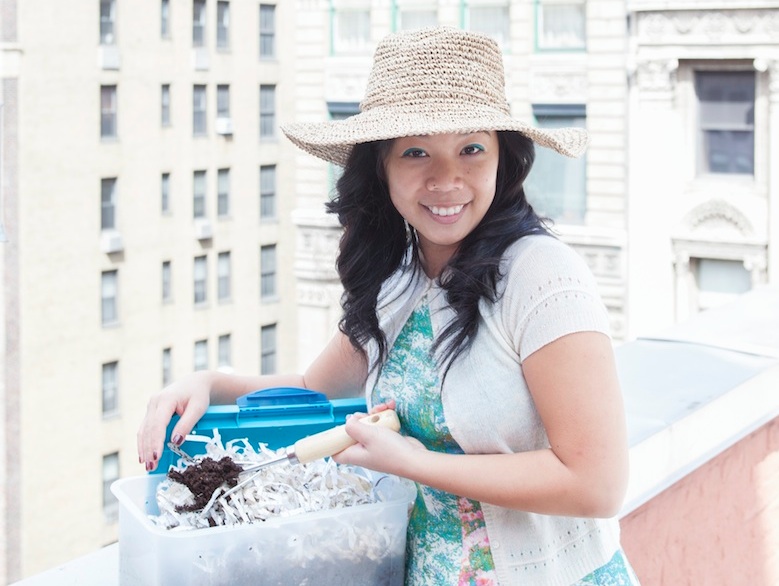
A recent report indicates that a third of our food — 32 million metric tons — is wasted and winds up in American landfills each year, but it’s International Compost Awareness Week again and I still haven’t learned to eat my radish tops.
I salivated over WastED but didn’t cook my own kale ribs; I bought $6 mugs of bone broth but didn’t simmer any carcasses. My consumption patterns would indicate my model citizenry but the vegetable shavings languishing in my freezer know otherwise. Criticisms of dollar voting and lifestyle environmentalism aside, composting is a good thing and I should do better.
Aside from buying only the groceries you know you can eat and saving your leftovers, it’s the best way to reduce household food waste. It’s also not very hard once you develop a habit, and living in New York means you have options which range from fermenting your own scraps to dropping them off at the Greenmarket.
Generally speaking, you can compost any fruit and vegetable scraps, non-greasy food scraps, coffee grounds and filters and dead houseplants. With the exception of bokashi fermentation (read more below), you can’t compost meat, grease, dairy or any of those “compostable” to-go cups (those require an industrial-scale composter).
Feeling squeamish about keeping food scraps in the house? You don’t have to worry — take care of them properly and they won’t smell. I freeze my scraps in a brown paper bag (the bag is compostable, too), and odor-free compost bins are surprisingly effective. In a pinch, an empty yogurt container will do the trick just as well. Fire escapes and balconies are also a good option as long as you make sure your bin is airtight to prevent pests.
Here are a few city-friendly composting strategies for backyard-less waste reduction:
Bokashi Fermentation
While researching this article, I called Rebecca Louie, aka The Compostess, for a crash course on vermicomposting. Her new book Compost City will be hitting bookshelves on May 19 (pre-order here), and the entire tome is devoted to breaking down food scraps in small spaces. Although she’s still a huge proponent of wormy systems, the book actually gives a lot of attention to bokashi fermentation, which works particularly well for small offices and households that produce more food scraps than worms can handle.
Bokashi fermentation is new to me, and the capabilities of the system blew my mind. Unlike vermicomposting and city organics collection, bokashi fermentation allows you to ferment meat, dairy, cooked food, condiments and wine. Basically, you keep a bucket under your sink and layer your food scraps with bokashi powder (buy it online or make your own). Your scraps ferment in the airtight environment for two weeks, and then you bury them in a garden or a window box and let nature finish the job. An added bonus: If you are able to collect the liquid runoff, you can use it to clear your drains. Check out Rebecca’s step-by-step instructions here.

Indoor Vermicompost
Indoor vermicomposting sounds slimy and scary, but there are tons of resources out there to help you get started. You can buy a bin and worms for $35 from the city’s at-cost equipment program (compared with $80 or more retail), but you’ll need to pay attention to what you’re feeding your worms to keep them healthy. “Like any ecosystem, you’re going to want to achieve the right balance in the little world that you’ve created for your worms,” Rebecca says, adding that the common statistic that worms eat half their weight per day is only true under ideal conditions.
The most common mistakes new composters make? Overfeeding the worms. Rebecca recommends freezing food scraps in pint-sized portions, which kills pest eggs and helps get rid of excess water. Watch your worms as they work through one feeding, then add the next thawed serving as needed. For more help getting started, here’s a slideshow from the NYC Compost Project with a “healthy worm bin” checklist; we also found Urban Worm Composting’s FAQ section particularly helpful. And if you’re in dire need of a compost doctor, Rebecca does make house calls — contact her through her website.
City Pickup
If you’re lucky enough to live in a pilot neighborhood, the Department of Sanitation has you covered. Hopefully the rest of the city will get there soon, although NYC needs to find a new compost processor to expand the program. It’s not easy finding a home for NYC’s waste, and while we’d all love to have those adorable (and rodent-proof!) brown bins for our curbs, it’s probably unreasonable to keep shoving scraps in the freezer until the city catches up.
Home Pickup
BK Rot, a Brooklyn-based compost pickup service, will pick up your compost once a week on a bike. The tiny youth-led project turns food scraps into compost and works with organizations like Green Guerillas to provide summer employment opportunities for students. For just $15 per month, they’ll pick up your food scraps every Sunday.
Greenmarket Dropoff
There are 54 Greenmarkets across the city, and 38 of them collect compost. Simply freeze your scraps throughout the week and drop them off when you do your shopping — but make sure to check collection hours first as they sometimes differ from market hours. Here’s a list of what they can and can’t turn into soil.
Community Garden Composting
Many community gardens have their own compost programs that accept scraps from neighbors. Policy varies by location, but here’s a map of gardens in the city to get you started. Know of a garden that needs equipment? Low-cost bins from the city accommodate up to 11 cubic feet per week, and there are several ways to build your own for greater capacity. Want to go the extra mile for your neighborhood’s garden? The city also runs a Master Composter Course, which costs a mere $40 and will equip you to build equipment and manage your own community project.



